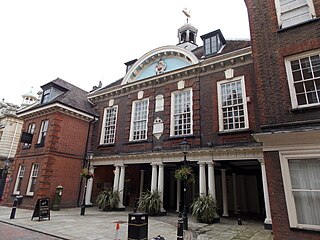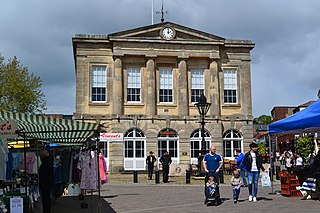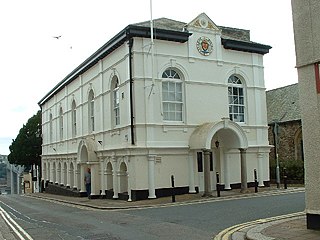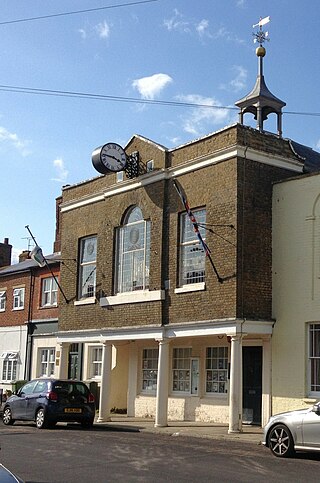
The Borough of Stafford is a local government district with borough status in Staffordshire, England. It is named after Stafford, its largest town, which is where the council is based. The borough also includes the towns of Stone and Eccleshall, as well as numerous villages and surrounding rural areas.

The Rochester Guildhall is an historic building located in the High Street in Rochester, Kent, England. It is a Grade I listed building.

The North Stafford Hotel is a Grade II* listed hotel in Stoke-on-Trent, Staffordshire, England, opposite the city's railway station, also a Grade II* listed building.

County Buildings is a municipal facility at Martin Street in Stafford, Staffordshire. The building, which is the meeting place for both Staffordshire County Council and Stafford Borough Council, is a Grade II* listed building.

Gloucester Guildhall is a former municipal building in Eastgate Street, Gloucester, which is now used as an arts and theatre venue. It is a Grade II listed building.

The Guildhall is a municipal building in High Street, Newcastle-under-Lyme. It is a Grade II listed building.

Folkestone Town Hall, also known as The Guildhall, is a municipal building in Guildhall Street, Folkestone, Kent, England. The town hall serves as the headquarters of Folkestone Town Council, and also houses the Folkestone Museum. It is a Grade II listed building.

Andover Guildhall is a municipal building in the High Street, Andover, Hampshire, England. The guildhall, which was the headquarters of Andover Borough Council, is a Grade II* listed building.

Willenhall Library, formerly Willenhall Town Hall, is a municipal building in Walsall Street in Willenhall, West Midlands, England. The building, which was the headquarters of Willenhall Urban District Council, is a locally listed building.

Oswestry Guildhall is a municipal building in Bailey Head in Oswestry, Shropshire, England. The structure, which was the meeting place of Oswestry Municipal Borough Council, is a Grade II listed building.

Louth Town Hall is a municipal building in Eastgate in Louth, Lincolnshire, England. The structure, which was the meeting place of Louth Borough Council, is a Grade II listed building.

Saltash Guildhall is a municipal building in Fore Street, Saltash, Cornwall, England. The structure, which was the meeting place of Saltash Borough Council, is a Grade II listed building.

Tavistock Town Hall is a municipal building in Bedford Square, Tavistock, Devon, England. The structure, which remains the main venue for civic events in the town, is a Grade II listed building.

Conwy Guildhall is a municipal structure in Rose Hill Street, Conwy, Wales. The guildhall, which is the meeting place of Conwy Town Council, is a Grade II listed building.

Liskeard Guildhall is a municipal building in Pike Street, Liskeard, Cornwall, England. The structure, which was the meeting place of Liskeard Borough Council, is a Grade II* listed building.

Queenborough Guildhall is a former municipal building in the High Street in Queenborough, Kent, England. The structure, which is currently used as a museum, is a Grade II listed building.

Hanley Town Hall is a municipal building in Albion Square in Hanley, Staffordshire, England. The building, which is used as the local register office, is a Grade II listed building.

The Old Town Hall is a municipal building in the Market Place in Wilton, Wiltshire, England. The structure, which is currently used as a Baptist church, is a Grade II listed building.

Bewdley Guildhall is a municipal building in Load Street in Bewdley, Worcestershire, England. The structure, which is the meeting place of Bewdley Town Council, is a Grade II* listed building.

Milnrow Town Hall, formerly known as Milnrow Council Offices, is a former municipal building in Newhey Road, Milnrow, a town in Greater Manchester in England. The building, which served as the offices and meeting place of Milnrow Urban District Council, is currently vacant.





















